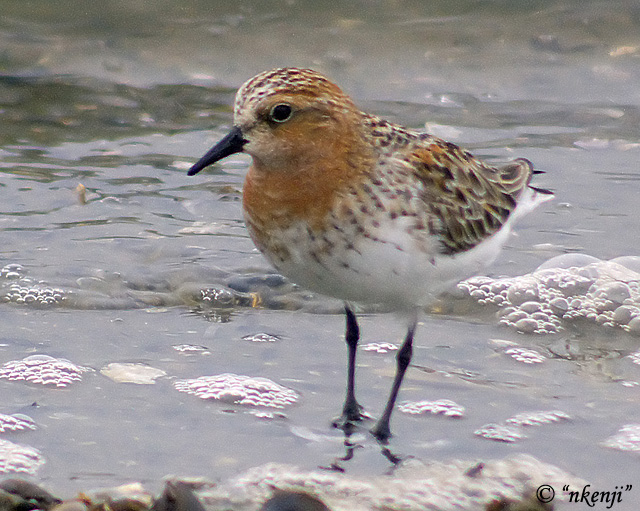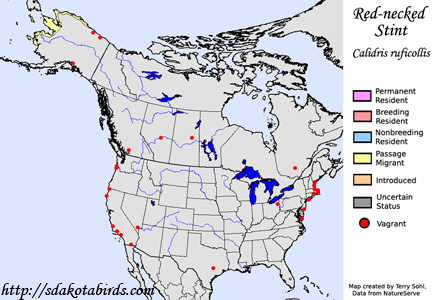| Length: 6.25inches | Wingspan: 41 inches | Seasonality: Non-resident in South Dakota |
| ID Keys: Red throat and neck on breeding plumaged birds, scaly wing pattern on breeding birds with rufous on scapulars. Non-breeding birds plain gray on upperparts, white below. | ||
 The
Red-necked Stint is a bird that normally breeds in Siberia, and winters in
Australia and the surrounding region. However, small numbers sometimes
stray across the Bering Sea and breed in western Alaska. Red-necked
Stints have also been found in widely scattered locations in North America
during migration, with most sightings occurring along the coasts, but
records have also occurred on the continent's interior.
The
Red-necked Stint is a bird that normally breeds in Siberia, and winters in
Australia and the surrounding region. However, small numbers sometimes
stray across the Bering Sea and breed in western Alaska. Red-necked
Stints have also been found in widely scattered locations in North America
during migration, with most sightings occurring along the coasts, but
records have also occurred on the continent's interior.
Habitat: Found on tundra close to the coast when they occur in western Alaska during breeding season. At other seasons, found in tidal mudflats, estuaries, and sometimes on mudflats on interior water bodies.
Diet: Feeds on insects and insect larvae during the summer breeding season. During migration and in winter, they will feed on a number of small marine creatures, including small crustaceans, mollusks, and marine worms.
Behavior: Forages by walking along the shore or in very shallow water, picking food items directly from the ground, or occasionally probing with their bill.
Nesting: The nest of a Red-necked Stint is a shallow depression on the ground, lined with leaves or other material. The female usually lays 4 eggs, and both parents help to incubate them. When the eggs hatch, the young soon leave the nest and start to forage for themselves. The male tends to the young, but the female often leaves shortly after the young have hatched.
Song: Flight call of a Red-necked Stint is a high-pitched quip.
Migration: Migratory. Most Red-necked Stints breed in Siberia, with a handful sometimes breeding in western Alaska. Birds winter in Australia, New Zealand, and areas in southeastern Asia.
Interactive eBird Map: Click here to access an interactive eBird map of Red-necked Stint sightings
Similar Species: The red-colored neck on breeding plumaged birds makes the species easy to differentiate from other shorebirds found in North America. The Little Stint, only a very rare visitor to North America, is the most similar in overall appearance. Non-breeding plumaged birds could be confused with other small shorebirds common in North America, such as Western Sandpiper, Semipalmated Sandpiper, or Least Sandpiper.
Conservation Status: Populations are relatively large, found over a wide geographic area, and aren't decreasing at an alarming rate. The IUCN lists the Red-necked Stint as a species of "Least Concern".
Further Information: 1) Australian Government - Department of Sustainability, Environment, Water, Population, and Communities - Red-necked Stint
2) ARKIVE.org - Red-necked Stint
3) BirdLife International - Red-necked Stint
Photo Information: Photo taken by "nkenji" - Photo licensed under Creative Commons Attribution NonCommercial NoDerivs 2.0 Generic License.
| Click below for a higher-resolution map |
 |
| South Dakota Status: Non-resident in South Dakota |
Additional Red-necked Stint Photos (coming soon!!)
